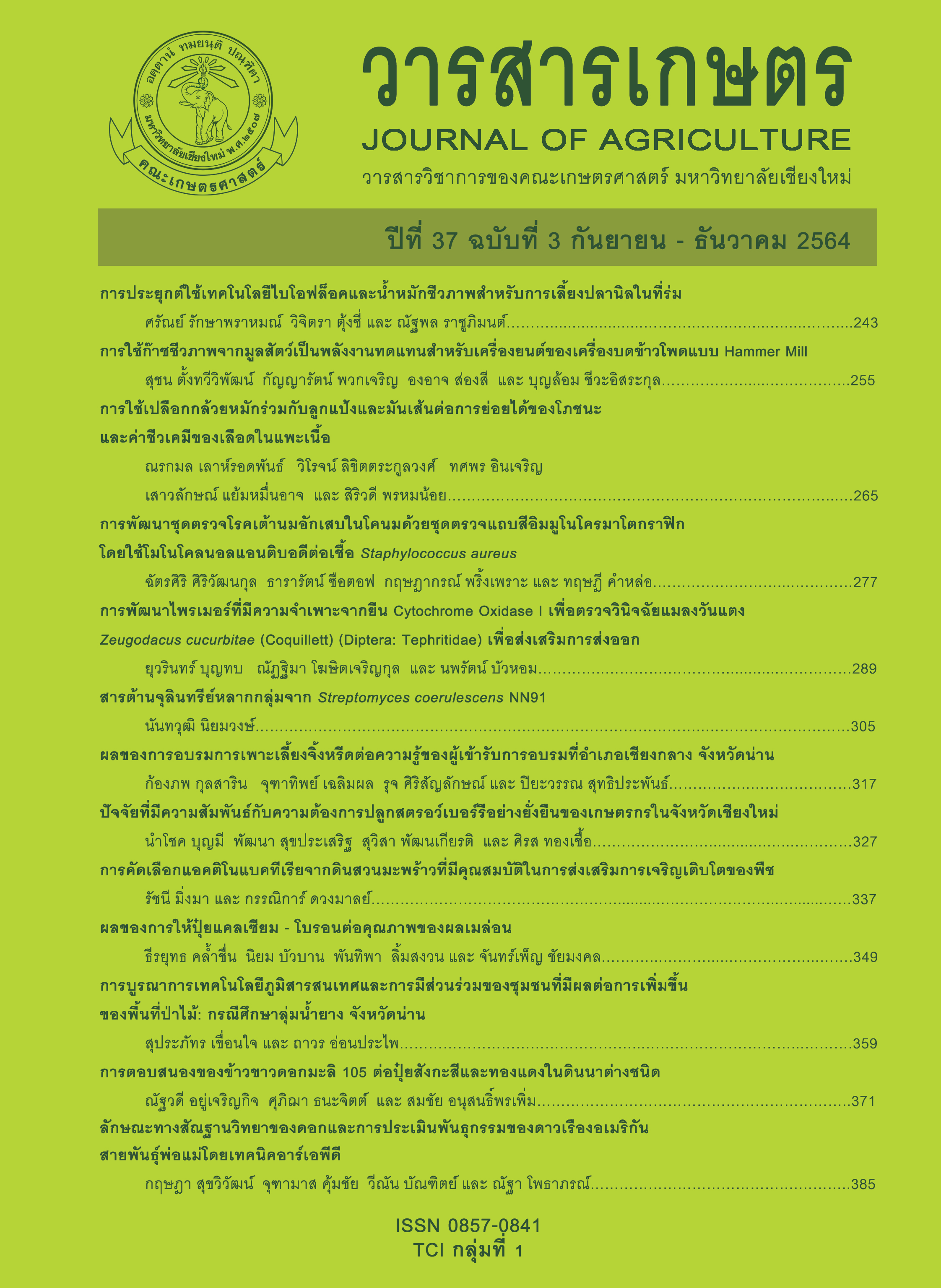Development of Cytochrome Oxidase I Gene Specific Primers for Diagnosis of Melon Fly, <I>Zeugodacus cucurbitae</I> (Coquillett) (Diptera: Tephritidae) for Export Promotion
Main Article Content
Abstract
The melon fly, Zeugodacus cucurbitae (Coquillett), is a quarantine pest species for many countries. Larvae of melon fly are intercepted by quarantine inspections, but their morphological similarity to other fruit fly species makes identification difficult and unreliable. Rapid, precise identification of immature fruit flies associated with imported/exported fresh produce is essential to ensure appropriate biosecurity decisions at quarantine barriers, or where commodities are inspected prior to export. Species-specific primers were designed by amplifying the cytochrome oxidase I (cox1) gene to identify Z. cucurbitae in its various life stages. The species - specific assay demonstrated high specificity, sensitivity and reliability for 11 species examined (Bactrocera carambolae, B. correcta, B. dorsalis, B. latifrons, B. umbrosa, Dacus longicornis, Zeugodacus apicalis, Z. caudatus, Z. cilifera, Z. cucurbitae and Z. tau). This study demonstrated the feasibility of using species - specific diagnostic tools (utilising 83 base pair sequences) for identifying fruit fly populations from all regions of Thailand. The primers were also validated on samples intercepted by plant inspections at Suvarnabhumi airport of agricultural products destined for exporting from Thailand. The primer pairs from this research are accurate, fast and efficient. Thus, they make it possible to detection of quarantine pests at early points in the production and export pathway. The present study is a model for developing diagnostic techniques for various pests which will in turn: promote trading partner confidence in Thai certification systems and enhance the diversity, quality and value of Thai agricultural products.
Article Details
References
Allwood, A.J. and L. Leblanc. 1997. Losses caused by fruit flies (Diptera: Tephritidae) in seven Pacific Island countries. pp. 208-211. In: A.J. Allwood and R.A.I. Drew (eds.). Management of Fruit Flies in the Pacific. ACIAR Proceedings No. 76, Canberra.
Armstrong, K.F. and S.L. Ball. 2005. DNA barcodes for biosecurity: invasive species identification. Philosophical Transactions of the Royal Society of London B: Biological Sciences 360(1462): 1813 -1823.
Asokan, R., K.B. Rebijith, S.K. Singh, A.S. Sidhu, S. Siddharthan, P.K. Karanth, R. Ellango and V.V. Ramamurthy. 2011. Molecular identification and phylogeny of Bactrocera species (Diptera: Tephritidae). Florida Entomologist 94(4): 1026-1035.
Boontop, Y., C. Buamas, K. Sonsiri, J. Duangthisan and S. Kaewsawat. 2020. Identification of economically important fruit fly larvae of Dacini (Diptera: Tephritidae) in Thailand using scanning electron microscopy (SEM). Thai Agricultural Research Journal 38(3): 293-306.
Boontop, Y., M.K. Schutze, A.R. Clarke, S.L. Cameron and M.N. Krosch. 2017. Signatures of invasion: using an integrative approach to infer the spread of melon fly, Zeugodacus cucurbitae (Diptera: Tephritidae), across Southeast Asia and the West Pacific. Biological Invasions 19(5): 1597-1619.
De Meyer, M., H. Delatte, M. Mwatawala, S. Quilici, J-F. Vayssieres and M. Virgilio. 2015. A review of the current knowledge on Zeugodacus cucurbitae (Coquillett) (Diptera: Tephritidae) in Africa, with a list of species included in Zeugodacus. ZooKeys 540: 539-557.
Dhillon, M.K., R. Singh, J.S. Naresh and H.C. Sharma. 2005. The melon fruit fly, Bactrocera cucurbitae: A review of its biology and management. Journal of Insect Science 5(1): 40, doi: 10.1093/jis/5.1.40.
Drew, R.A.I. and M.C. Romig. 2013. Tropical Fruit Flies (Tephritidae: Dacinae) of South-East Asia: Indomalaya to North-West Australasia. CABI, Wallingford. 653 p.
Drew, R.A.I. and M.C. Romig. 2016. Keys to the Tropical Fruit Flies (Tephritidae: Diptera) of South-East Asia: Indomalaya to North-West Australasia. CABI, Wallingford. 487 p.
Folmer, O., M. Black, W. Hoeh, R. Lutz and R. Vrijenhoek. 1994. DNA primers for amplification of mitochondrial cytochrome c oxidase subunit I from diverse metazoan invertebrates. Molecular Marine Biology and Biotechnology 3(5): 294-299.
Hall, T. A. 1999. BioEdit: a user-friendly biological sequence alignment editor and analysis program for Windows 95/98/NT. Nucleic Acids Symposium Series 41: 95-98.
Jiang, F., Z.H. Li, Y.L. Deng, J.J. Wu, R.S. Liu and N. Buahom. 2013. Rapid diagnosis of the economically important fruit fly, Bactrocera correcta (Diptera: Tephritidae) based on a species-specific barcoding cytochrome oxidase I marker. Bulletin of Entomological Research 103(3): 363-371.
Koyama, J., H. Kakinohana and T. Miyatake. 2004. Eradication of the melon fly, Bactrocera cucurbitae, in Japan: importance of behavior, ecology, genetics, and evolution. Annual Reviews of Entomology 49: 331-349.
Piñero, J.C., I. Jacome, R. Vargas and R.J. Prokopy. 2006. Response of female melon fly, Bactrocera cucurbitae, to host-associated visual and olfactory stimuli. Entomologia Experimentalis et Applicata 121(3): 261-269.


